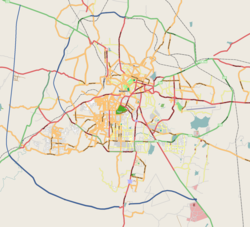This article needs additional citations for verification .(September 2011) |
Basavanagudi | |
|---|---|
Neighbourhood | |
 Bull Temple, Basavanagudi | |
| Coordinates: 12°56′N77°34′E / 12.94°N 77.57°E | |
| Country | India |
| State | Karnataka |
| Metro | Bengaluru |
| Population (Census 2011) | |
• Total | 32,640 [1] |
| Time zone | UTC+5:30 (IST) |
| PIN | 560004,560019,560028,560050 |
Basavanagudi is a residential and commercial locality in the Indian city of Bengaluru. Basavanagudi is one of the oldest localities of Bangalore evidenced by the fact that it is home to four inscriptions, three Kannada and one Tamil and also one of the poshest areas of Bangalore. [2] [3] [4] It is located in South Bangalore, along the borders of Jayanagar and Lalbagh Botanical Gardens. The name "Basavanagudi" refers to the Bull Temple, which contains a monolithic statue of the Nandi Bull. The word Basava in Kannada means bull, and gudi means temple. [5] The main commercial street in Basavanagudi is DVG Road, which is home to numerous retail businesses - several of them dating back to the 1920s and 1930s. Towards the middle of DVG Road is Gandhi Bazaar, known for its market which sells fresh flowers, fruits, and vegetables. [6] The neighbourhood includes several historic restaurants, notably Vidyarthi Bhavan, a vegetarian restaurant which opened in 1943. [7] Basavanagudi is also home to B.M.S. College of Engineering, established in 1946, which holds the distinction of being the first private engineering college in India. [8]

